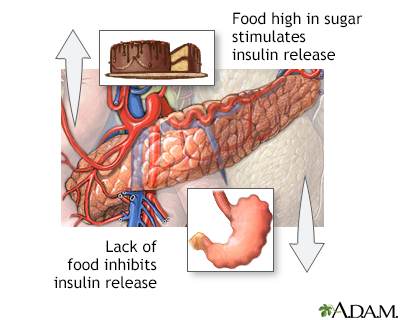Pregnancy SmartSiteTM
Hypoglycemia; Insulin shock; Insulin reaction; Diabetes - hypoglycemia DefinitionLow blood sugar is a condition that occurs when the body's blood sugar (glucose) decreases and is too low. Blood sugar below 70 mg/dL (3.9 mmol/L) is considered low. Blood sugar at or below this level can be harmful. The medical name of low blood sugar is hypoglycemia. CausesInsulin is a hormone made by the pancreas. Insulin is needed to move glucose into cells where it is stored or used for energy. Without enough insulin, glucose builds up in the blood instead of going into the cells. This leads to symptoms of diabetes. Low blood sugar occurs due to any of the following:
Low blood sugar is common in people with diabetes who are taking insulin or certain other medicines to control their diabetes. However, many other diabetes medicines do not cause low blood sugar. Exercise can also lead to low blood sugar in people taking insulin to treat their diabetes. Babies born to mothers with diabetes may have severe drops in blood sugar right after birth. In people who do not have diabetes, low blood sugar may be caused by:
SymptomsSymptoms you may have when your blood sugar gets too low include:
In many people with diabetes, low blood sugar causes nearly the same symptoms every time it happens. Not everybody feels low blood sugar symptoms the same way. Some symptoms, like hunger or sweating, occur when blood sugar is only slightly low. More severe symptoms, such as unclear thinking or seizure, may occur when the blood sugar is much lower (less than 54 mg/dL or 3.0 mmol/L). Even if you do not have symptoms, your blood sugar could still be too low (called hypoglycemic unawareness). You may not even know you have low blood sugar until you faint, have a seizure, or go into a coma. If you have diabetes, ask your health care provider if wearing a continuous glucose monitor can help you detect when your blood sugar is getting too low to help prevent a medical emergency. Some continuous glucose monitors can alert you and other people that you designate when your blood sugar decreases below a set level. If you have diabetes, keeping good control of your blood sugar can help prevent low blood sugar. Talk to your provider if you're not sure about the causes and symptoms of low blood sugar. Exams and TestsWhen you have low blood sugar, the reading will be lower than 70 mg/dL (3.9 mmol/L) on your glucose monitor. Your provider may ask you to wear a small monitor that measures your blood sugar every 5 minutes (continuous glucose monitor). The device is typically worn for 3 to 14 days. The data is downloaded to find out if you're having periods of low blood sugar that are going unnoticed. If you're admitted to the hospital, you'll likely have blood samples taken from your vein to:
TreatmentThe goal of treatment is to correct your low blood sugar level. It is also important to try and identify the reason why the blood sugar was low to prevent another low blood sugar episode from happening. If you have diabetes, it is important that your provider teaches you how to treat yourself for low blood sugar. Treatment may include:
Or you may have been told to give yourself a shot of glucagon. This is a medicine that raises blood sugar. If low blood sugar is caused by an insulinoma, surgery to remove the tumor will be recommended. Possible ComplicationsSevere low blood sugar is a medical emergency. It can cause seizures and brain damage. Severe low blood sugar that causes you to become unconscious is called hypoglycemic or insulin shock. Even one episode of severe low blood sugar may make it less likely for you to have symptoms that allow you to recognize another episode of low blood sugar. Episodes of severe low blood sugar can make people afraid to take insulin as prescribed by their provider. When to Contact a Medical ProfessionalIf signs of low blood sugar do not improve after you have eaten a snack that has sugar:
Get medical help right away for a person with diabetes or low blood sugar who:
ReferencesAmerican Diabetes Association Professional Practice Committee. 6. Glycemic Goals and Hypoglycemia: Standards of Care in Diabetes-2024. Diabetes Care. 2024;47(Suppl 1):S111-S125. PMID: 38078586 pubmed.ncbi.nlm.nih.gov/38078586/. Cryer PE, Arbeláez AM. Hypoglycemia. In: Melmed S, Auchus RJ, Goldfine AB, Koenig RJ, Rosen CJ, eds. Williams Textbook of Endocrinology. 14th ed. Philadelphia, PA: Elsevier; 2020:chap 38. | |
| |
Review Date: 2/28/2024 Reviewed By: Sandeep K. Dhaliwal, MD, board-certified in Diabetes, Endocrinology, and Metabolism, Springfield, VA. Also reviewed by David C. Dugdale, MD, Medical Director, Brenda Conaway, Editorial Director, and the A.D.A.M. Editorial team. The information provided herein should not be used during any medical emergency or for the diagnosis or treatment of any medical condition. A licensed medical professional should be consulted for diagnosis and treatment of any and all medical conditions. Links to other sites are provided for information only -- they do not constitute endorsements of those other sites. No warranty of any kind, either expressed or implied, is made as to the accuracy, reliability, timeliness, or correctness of any translations made by a third-party service of the information provided herein into any other language. © 1997- A.D.A.M., a business unit of Ebix, Inc. Any duplication or distribution of the information contained herein is strictly prohibited. | |

 Food and insulin r...
Food and insulin r... 15/15 rule
15/15 rule Low blood sugar sy...
Low blood sugar sy...
